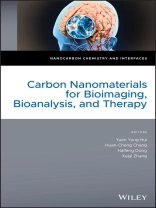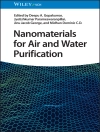A comprehensive reference on biochemistry, bioimaging, bioanalysis, and therapeutic applications of carbon nanomaterials
Carbon nanomaterials have been widely applied for biomedical applications in the past few decades, because of their unique physical properties, versatile functionalization chemistry, and biological compatibility. This book provides background knowledge at the entry level into the biomedical applications of carbon nanomaterials, focusing on three applications: bioimaging, bioanalysis, and therapy.
Carbon Nanomaterials for Bioimaging, Bioanalysis and Therapy begins with a general introduction to carbon nanomaterials for biomedical applications, including a discussion about the pros and cons of various carbon nanomaterials for the respective therapeutic applications. It then goes on to cover fluorescence imaging; deep tissue imaging; photoacoustic imaging; pre-clinical/clinical bioimaging applications; carbon nanomaterial sensors for cancer and disease diagnosis; targeted cancer therapy; and photothermal/photodynamic therapy. Each chapter briefly introduces the biomedical application and emphasizes the most appropriate carbon nanomaterial(s) for the application.
- Provides an introduction to the biomedical applications of carbon nanomaterials for early-career scientists, as well as background and context for mid-career scientists and researchers
- Contains four sections covering biochemistry, bioimaging, bioanalysis, and therapeutic applications of carbon nanomaterials
- Presented by experts who have strong background in the field of nanotechnology for biomedical applications
- Covers a hot area of research which has very unique physical properties, versatile functionalization chemistry, and biological compatibility
Carbon Nanomaterials for Bioimaging, Bioanalysis and Therapy is an excellent resource for academic researchers and industrial scientists working on preparation and bio-application of carbon nanomaterials, biomedical engineering, and nanotechnology.
Table of Content
List of Contributors xiii
Series Preface xix
Preface xxi
Part I Basics of Carbon Nanomaterials 1
1 Introduction to Carbon Structures 3
Meng-Chih Su and Yuen Yung Hui
1.1 Carbon Age 3
1.2 Classification 4
1.3 Fullerene 4
1.4 Carbon Nanotubes 6
1.4.1 Structure 6
1.4.2 Electronics 8
1.5 Graphene 10
1.5.1 Structure 10
1.5.2 Electronics 11
1.6 Nanodiamonds and Carbon Dots 12
Acknowledgment 13
References 13
2 Using Polymers to Enhance the Carbon Nanomaterial Biointerface 15
Goutam Pramanik, Jitka Neburkova, Vaclav Vanek, Mona Jani, Marek Kindermann, and Petr Cigler
2.1 Introduction 15
2.2 Colloidal Stability of CNMs 16
2.3 Functionalization of CNMs with Polymers 18
2.3.1 Noncovalent Approaches 18
2.3.2 Covalent Approaches 18
2.4 Influence of Polymers on the Spectral Properties of CNMs 19
2.5 Functionalizing CNMs with Antifouling Polymers for Bioapplications 22
2.6 Functionalization of CNMs with Stimuli‐Responsive Polymers 26
2.6.1 Carbon Nanoparticles with Thermoresponsive Polymers 27
2.6.2 p H‐Responsive Carbon Nanoparticles 27
2.6.3 Redox‐Responsive Carbon Nanoparticles 28
2.6.4 Multi‐Responsive Carbon Nanoparticles 28
2.7 Functionalization of CNMs with Polymers for Delivery of Nucleic Acids 29
2.8 Outlook 32
Acknowledgments 34
References 34
3 Carbon Nanomaterials for Optical Bioimaging and Phototherapy 43
Haifeng Dong and Yu Cao
3.1 Introduction 43
3.2 Surface Functionalization of Carbon Nanomaterials 43
3.3 Carbon Nanomaterials for Optical Imaging 45
3.3.1 Intrinsic Fluorescence of Carbon Nanomaterials 45
3.3.2 Imaging Utilizing Intrinsic Fluorescence Features of Carbon Nanomaterials 46
3.3.3 Imaging with Fluorescently Labeled Carbon Nanomaterials 51
3.4 Carbon Nanomaterials for Phototherapies of Cancer 51
3.4.1 Photothermal Therapy 52
3.4.2 Photodynamic Therapy 53
3.5 Conclusions and Outlook 56
References 56
Part II Bioimaging and Bioanalysis 63
4 High‐Resolution and High‐Contrast Fluorescence Imaging with Carbon Nanomaterials for Preclinical and Clinical Applications 65
John Czerski and Susanta K. Sarkar
4.1 Introduction 65
4.2 Survey of Carbon Nanomaterials 66
4.2.1 Fluorescent Nanodiamonds 66
4.2.2 Carbon Nanotubes 66
4.2.3 Graphene 69
4.2.4 Carbon Nanodots 69
4.3 Fluorescent Properties of FNDs and SWCNTs 69
4.3.1 FNDs 69
4.3.2 SWCNTs 71
4.4 Survey of High‐Resolution and High‐Contrast Imaging 71
4.4.1 General Considerations for Eventual Human Use 71
4.4.2 General Considerations for Achieving High‐Resolution and High‐Contrast Imaging 72
4.4.2.1 Photoacoustic Imaging (PAI) 72
4.4.2.2 X‐ray Computed Tomographic (CT) Imaging 73
4.4.2.3 Magnetic Resonance Imaging (MRI) 73
4.4.2.4 Image Alignment and Drift Correction 74
4.4.3 Preclinical and Clinical Optical Imaging with CNMs 74
4.4.4 Optical Imaging in the Short‐Wavelength Window (~650–950 nm) 74
4.4.4.1 Optical Imaging beyond the Diffraction Limit 75
4.4.4.2 Selective Modulation of Emission 75
4.4.4.3 Time‐Gated Fluorescence Lifetime Imaging 77
4.4.5 Optical Imaging in the Long‐Wavelength Window (~950–1400 nm) 77
4.5 Conclusions 78
References 79
5 Carbon Nanomaterials for Deep‐Tissue Imaging in the NIR Spectral Window 87
Stefania Lettieri and Silvia Giordani
5.1 Introduction 87
5.1.1 Transparent Optical Windows in Biological Tissue 87
5.1.2 Near‐Infrared Imaging Materials 88
5.2 Carbon Nanomaterials for NIR Imaging 89
5.2.1 Biocompatibility of CNMs 90
5.2.2 Fluorescence of CNMs Probes 91
5.2.3 Covalent and Noncovalent Functionalization 91
5.2.4 CNMs as Bioimaging Platforms 91
5.2.4.1 Fullerene 91
5.2.4.2 Carbon Nanotubes 93
5.2.4.3 Graphene Derivatives 99
5.2.4.4 Carbon Dots 100
5.2.4.5 Carbon Nano-onions 102
5.2.4.6 Nanodiamonds 104
5.3 Conclusions and Outlook 105
Acknowledgments 106
References 106
6 Tracking Photoluminescent Carbon Nanomaterials in Biological Systems 115
Simon Haziza, Laurent Cognet, and François Treussart
Chapter Summary 115
6.1 Introduction 115
6.2 Tracking Cells in Organisms with Fluorescent Nanodiamonds 116
6.3 Monitoring Inter and Intra Cellular Dynamics with Fluorescent Nanodiamonds 120
6.4 Single‐Walled Carbon Nanotubes: A Near‐Infrared Optical Probe of the Nanoscale Extracellular Space in Live Brain Tissue 127
6.5 Conclusion 131
References 132
7 Photoacoustic Imaging with Carbon Nanomaterials 139
Seunghyun Lee, Donghyun Lee, and Chulhong Kim
Chapter Summary 139
7.1 Introduction 139
7.2 Photoacoustic Imaging Systems 140
7.2.1 Photoacoustic Microscopy 141
7.2.2 Photoacoustic Computed Tomography 142
7.3 Photoacoustic Application of Carbon Nanomaterials 145
7.3.1 Carbon Nanomaterials for Photoacoustic Imaging Contrast Agents 146
7.3.2 Carbon Nanomaterials for Multimodal Photoacoustic Imaging 149
7.3.3 Carbon Nanomaterials for Photoacoustic Image‐Guided Therapy 156
7.3.4 Conclusions and Future Perspective 160
Acknowledgments 161
References 162
8 Carbon Nanomaterial Sensors for Cancer and Disease Diagnosis 167
Tran T. Tung, Kumud M. Tripathi, Tae Young Kim, Melinda Krebsz, Tibor Pasinszki, and Dusan Losic
8.1 Introduction 167
8.2 Detection of VOC by Using Gas/Vapor Sensors for Cancer and Disease Diagnosis 169
8.2.1 Carbon Nanodots (CNDs) and Graphene Quantum Dots (GQDs) for VOC Sensors 171
8.2.2 Carbon Nanotubes (CNTs) for VOC Sensors 173
8.2.3 Graphene for VOC Sensors 176
8.3 Detection of Biomarkers Using Biosensors for Cancer and Disease Diagnosis 179
8.3.1 Carbon Nanodot‐ and Graphene Quantum Dot‐Based Biosensors for Disease Biomarkers Detection 179
8.3.2 Carbon Nanotube‐Based Biosensors for Cancer Biomarker Detection 182
8.3.3 Carbon Nanotube‐Based Biosensors for Disease Biomarker Detection 186
8.3.4 Graphene‐Based Biosensors for Cancer Biomarker Detection 188
8.3.5 Graphene‐Based Biosensors for Disease Biomarker Detection 190
8.4 Conclusions and Perspectives 192
Acknowledgments 193
References 193
9 Recent Advances in Carbon Dots for Bioanalysis and the Future Perspectives 203
Jessica Fung Yee Fong, Yann Huey Ng, and Sing Muk Ng
9.1 Introduction 203
9.2 Fundamentals of CDs 205
9.2.1 Synthesis Approaches 205
9.2.2 Optical Properties 206
9.2.2.1 Absorbance and Photoluminescence (PL) 206
9.2.2.2 Quantum Yield (QY) 210
9.2.2.3 Photoluminescence Origins 210
9.2.2.4 Up‐Conversion Photoluminescence (UCPL) 211
9.2.2.5 Phosphorescence 212
9.2.3 Physical and Chemical Properties 213
9.2.4 Biosafety Assessments 214
9.3 Bioengineering of CDs for Bioanalysis 216
9.3.1 Functionalization Mechanism and Strategies 216
9.3.1.1 Chemical Functionalization 216
9.3.1.2 Doping 217
9.3.1.3 Coupling with Gold Nanoparticles 217
9.3.1.4 Fabrication onto Solid Polymeric Matrices 218
9.3.2 Biomolecules Grafted on CDs as Sensing Receptors 218
9.3.2.1 Deoxyribonucleic Acid (DNA) 218
9.3.2.2 Aptamers 219
9.3.2.3 Proteins/Peptides 219
9.3.2.4 Biopolymers 220
9.4 Bioanalysis Applications of CDs 221
9.4.1 Biosensing Mechanism/Transduction Schemes 221
9.4.1.1 Fluorescence 222
9.4.1.2 Chemiluminescence (CL) 223
9.4.1.3 Electrochemiluminescence (ECL) 224
9.4.1.4 Electrochemical 224
9.4.2 Uses of CDs in Bioanalysis 225
9.4.2.1 Heavy Metals/Elements 225
9.4.2.2 Reactive Oxygen/Nitrogen Species (ROS/RNS) 226
9.4.2.3 Oligonucleotides 227
9.4.2.4 Small Molecules/Pharmaceutical Drugs/Natural Compounds 228
9.4.2.5 Proteins 230
9.4.2.6 Enzyme Activities and Inhibitor Screening 231
9.4.2.7 p H 232
9.4.2.8 Temperature 234
9.4.3 Solid‐State Sensing for Point‐of‐Care Diagnostic Kits 234
9.4.4 Bioimaging/Real‐Time Monitoring 236
9.4.5 Theranostics 238
9.5 Future Perspectives 240
9.5.1 Better Understanding of PL Mechanisms 240
9.5.2 Establishment of Systematic Synthesis Protocol 241
9.5.3 QY Improvement and Spectral Expansion to Longer Wavelength 241
9.5.4 Sensitivity Improvement for Solid‐State Sensing 242
9.6 Conclusions 242
References 242
Part III Therapy 265
10 Functionalized Carbon Nanomaterials for Drug Delivery 267
Naoki Komatsu 267
10.1 Introduction 267
10.2 Direct Fabrication of Graphene‐Based Composite with Photosensitizer for Cancer Phototherapy 268
10.2.1 Fabrication of Graphene‐Based Composite with Chlorin e6 (G‐Ce6) 268
10.2.2 Characterization of G‐Ce6 268
10.2.3 In vitro Evaluation of G‐Ce6 for Cancer Phototherapy 272
10.3 Polyglycerol‐Functionalized Nanodiamond Conjugated with Platinum‐Based Drug for Cancer Chemotherapy 274
10.3.1 Synthesis of Polyglycerol‐Functionalized Nanodiamond Conjugated with Platinum‐Based Drug and Targeting Peptide 274
10.3.2 Characterization of Polyglycerol‐Functionalized Nanodiamond and the Derivatives 276
10.3.3 In vitro Evaluation of Polyglycerol‐Functionalized Nanodiamond Conjugated with Platinum‐Based Drug for Cancer Chemotherapy 279
10.4 Polyglycerol‐Functionalized Nanodiamond Hybridized with DNA for Gene Therapy 280
10.4.1 Synthesis and Characterization of Polyglycerol‐Functionalized Nanodiamond Conjugated with Basic Polypeptides 280
10.4.2 Characterization of Polyglycerol‐Functionalized Nanodiamond Hybridized with Plasmid DNA 280
10.5 Conclusions and Perspectives 283
Acknowledgments 285
References 285
11 Multifunctional Graphene‐Based Nanocomposites for Cancer Diagnosis and Therapy 289
Ayuob Aghanejad, Parinaz Abdollahiyan, Jaleh Barar, and Yadollah Omidi
11.1 Introduction 289
11.2 Multifunctional Graphene‐Based Composites for the Diagnosis/Therapy of Cancer 291
11.2.1 Metal‐Graphene Nanocomposites 292
11.2.1.1 Gold‐Graphene Composites 292
11.2.1.2 Magnetic Graphene Nanocomposites 294
11.2.2 Polymeric Graphene Nanocomposites 295
11.2.3 Graphene Biomaterials for MR Imaging 299
11.3 Multimodal Graphene‐Based Composites for the Radiotherapy of Cancer 300
11.4 Graphene‐Based Nanobiomaterials for Cancer Diagnosis 302
11.5 Conclusion 302
Acknowledgment 303
References 303
12 Carbon Nanomaterials for Photothermal Therapies 309
Jiantao Yu, Lingyan Yang, Junyan Yan, Wen‐Cheng Wang, Yi‐Chun Chen, Hung‐Hsiang Chen, and Chia‐Hua Lin
12.1 Introduction 309
12.2 GO for PTT 311
12.2.1 PTT‐Related Physical and Chemical Properties of GO 311
12.2.2 GO for in vitro PTT 312
12.2.3 GO for in vivo PTT 314
12.3 CNTs and CNHs for PTT 314
12.3.1 Physical and Chemical Properties of CNTs and CNHs Related to PTT 315
12.3.2 CNTs and CNHs for in vitro PTT 316
12.3.3 CNTs and CNHs for in vivo PTT 316
12.4 CDs and GDs for PTT 318
12.4.1 Physical and Chemical Properties of CDs and GDs Related to PTT 318
12.4.2 CDs and GDs for in vitro PTT 319
12.4.3 CDs and GDs for in vivo PTT 319
12.5 Fullerenes for PTT 320
12.5.1 Physical and Chemical Properties of Fullerenes Related to PTT 320
12.5.2 Fullerenes for in vitro PTT 320
12.5.3 Fullerenes for in vivo PTT 321
12.6 Carbon Nanomaterial‐Based Nanocomposites for PTT 321
12.6.1 GO‐Based Nanocomposites for PTT 322
12.6.2 CNT‐Based Nanocomposites for PTT 323
12.6.3 CD‐ and GD‐Based Nanocomposites for PTT 323
12.7 Carbon Nanomaterial‐Based Combined Therapy with PTT 324
12.7.1 Chemotherapy 324
12.7.2 RT 324
12.7.3 Photodynamic Therapy (PDT) 325
12.7.4 Gene Therapy 325
12.7.5 Immune Therapy 327
12.7.6 Theranostic Applications 328
12.8 Conclusions and Perspectives 329
References 330
Index 341
About the author
Editors
Yuen Yung Hui, is a Postdoctoral Research Fellow at the Institute of Atomic and Molecular Sciences, Academia Sinica, Taipei, Taiwan, Republic of China.
Huan-Cheng Chang, is a Distinguished Research Fellow at the Institute of Atomic and Molecular Sciences, Academia Sinica, Taipei, Taiwan, Republic of China.
Haifeng Dong, is a Professor at the University of Science and Technology Beijing, P.R. China.
Xueji Zhang, is Professor and Dean in the School of Chemistry & Biological Engineering at the University of Science & Technology Beijing, P.R. China.












